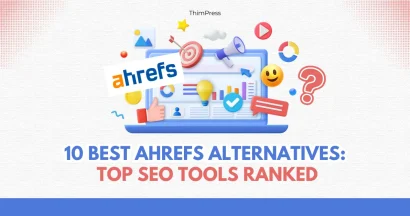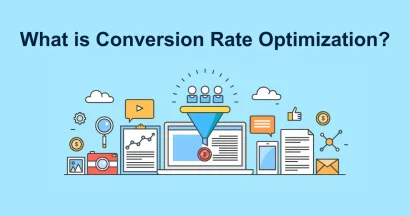AI in digital marketing and AI in web design are now part of everyday life, not just future trends. Smart ad platforms now optimize campaigns automatically, while websites adapt dynamically to user behavior in real-time. This subtle yet significant shift is changing how brands connect with their audiences online. As we move toward 2025, AI is set to become a vital tool for marketers and web developers alike. Supporting this trend, 78% of organizations report using AI in at least one function (Stanford AI Index, 2025), and the AI marketing industry is projected to reach $107.5 billion by 2028 (LinkedIn/industry analysis, 2024).
In this blog, we’ll examine how these changes are happening, which tools and tactics are making the biggest difference, and how businesses, from ad agencies to website developers, are staying ahead.
How AI Is Changing Digital Marketing in 2025?
Artificial Intelligence is no longer just a buzzword—it’s a practical engine powering nearly every digital marketing touchpoint in 2025. What once needed a team of analysts and days of testing can now happen instantly, driven by machine learning models that constantly adapt to new behaviors and signals. In practice, 65% of marketers say GenAI is already in their workflow (McKinsey, 2024).
For marketers, this shift means faster decisions, deeper personalization, and smarter use of data across the funnel. Let’s explore how AI is reshaping targeting, campaign optimization, and personalized engagement.
Smarter Targeting and Audience Segmentation
When people discuss AI in digital marketing, one of the first benefits mentioned is smarter audience targeting. But in 2025, this doesn’t just mean “better demographics.” AI has expanded segmentation far beyond age, gender, and location into something much more dynamic: real-time, behavior-driven targeting.
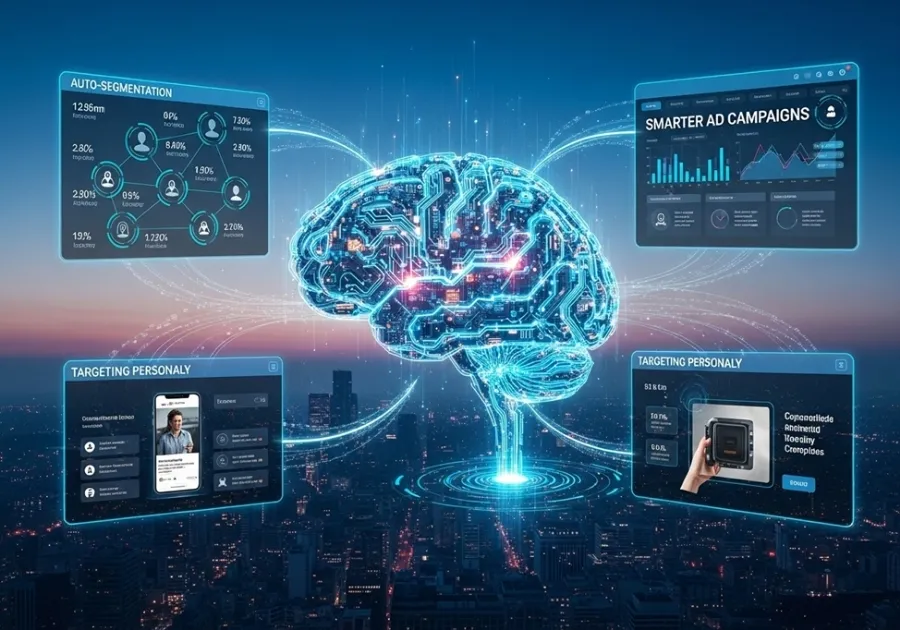
AI now monitors subtle user signals, from browsing habits, content engagement, and even hesitation to purchase, and uses them to generate micro-segments that update continuously. Instead of “women aged 25–35,” a campaign might target “users who compared competitor products this week and hesitated at checkout.” That level of detail wasn’t achievable before, and that’s why marketers are seeing improved ROI with AI-powered campaigns. Retailers using AI-powered personalization have reported 10–25% higher ROAS (Bain, 2024).
Another significant advancement is predictive audience mapping. By analyzing past behaviors, AI can forecast what users are likely to do next. This enables marketers to target customers before they act, making ads more relevant and timely. Tools like Google’s AI-powered audiences and Meta’s Advantage+ targeting are already demonstrating how effective this approach can be.
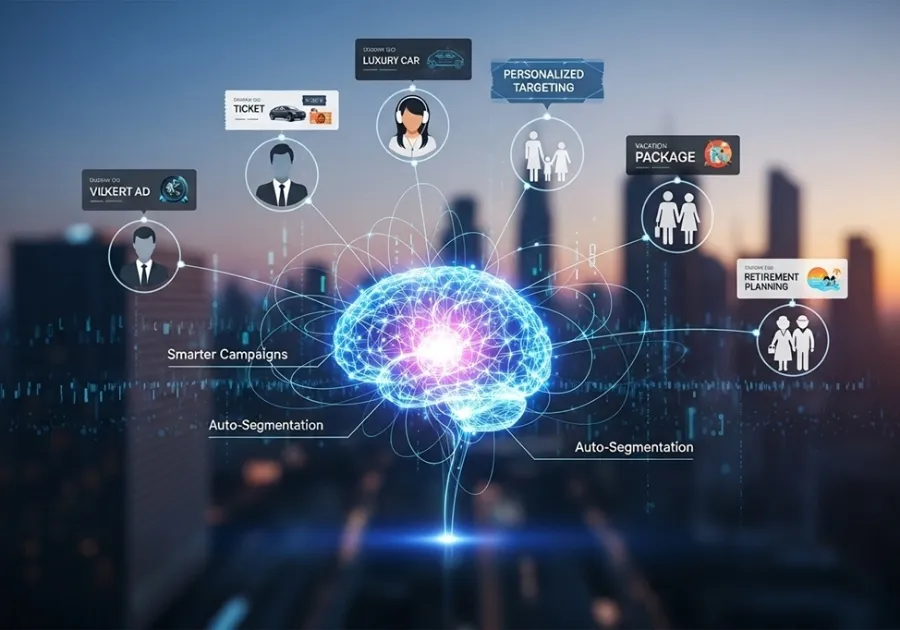
The outcome? Marketers spend less time guessing and more time engaging. AI doesn’t just identify audiences. It learns how they change, ensuring campaigns remain aligned with shifting consumer behaviors throughout 2025.
Campaign Optimization with AI Tools
Another major way AI is transforming digital marketing in 2025 is through campaign optimization. In the past, testing ad creatives, adjusting bids, and managing budgets were manual, time-consuming processes. Today, AI handles much of that automatically, and with better results. Across teams, 88% of marketers report using AI daily, citing faster decisions and less manual tweaking (EY, 2024)
One standout application is automated A/B testing. Instead of running two versions of an ad for weeks, AI tools can test dozens of variations simultaneously and instantly identify the winning creative. This not only saves time; it ensures campaigns adapt quickly to audience feedback, maximizing every ad dollar.
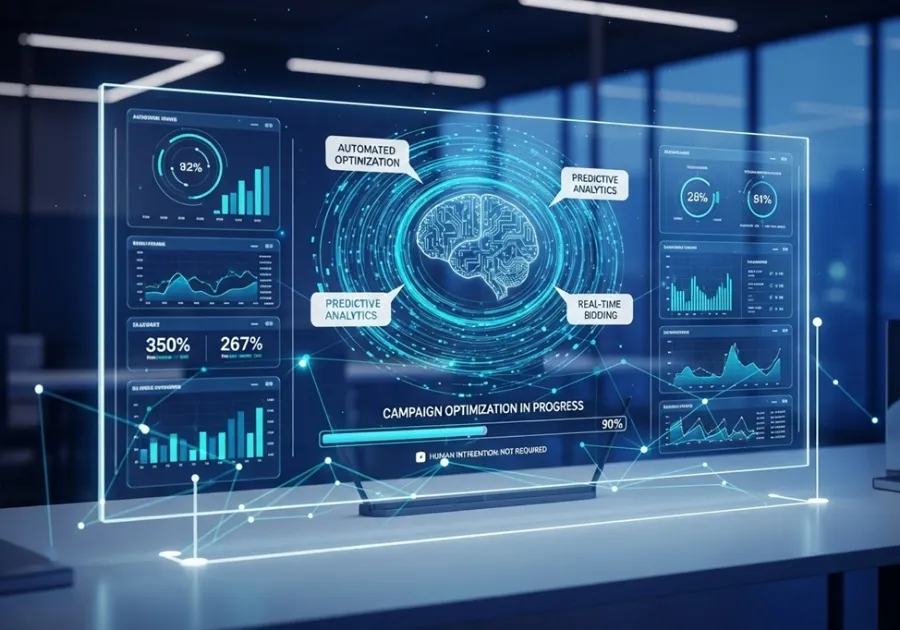
Budget and bid management have also become significantly more efficient thanks to AI. Platforms like Google Ads and Meta Ads now use machine learning to automatically adjust bidding strategies in real time, preventing overspending while maximizing visibility. This automation is especially beneficial for small to mid-sized businesses that lack a dedicated media-buying team.
One practical pattern we’ve seen at agencies like Mega Digital, which specialize in using AI-driven advertising tools for clients. By letting AI handle repetitive optimization tasks, marketers can focus on strategy, creativity, and long-term growth, while the AI fine-tunes campaigns behind the scenes.
The bottom line? With AI-powered optimization, campaigns are no longer “set it and forget it.” They are dynamic systems that continuously learn and improve, providing marketers with both efficiency and effectiveness at scale.
Hyper-Personalization at Scale
If there’s one area where AI in digital marketing truly excels in 2025, it’s personalization. Today’s consumers expect more than generic ads. They want experiences that feel tailored to them, whether it’s the product recommendations they see or the emails reaching their inbox. AI makes this possible, not just for a few customers, but on a massive scale.
Through dynamic creative generation, AI can automatically modify ad visuals, messaging, or CTAs to suit different audiences in real time. For example, a sports retailer can display running gear to fitness enthusiasts while promoting hiking equipment to outdoor explorers, all within the same campaign. This kind of adaptive creative ensures relevance without requiring endless manual effort.

Email and content personalization have also advanced. AI systems now analyze browsing history, past purchases, and even engagement timing to deliver messages that resonate at the right moment. Instead of sending one generic newsletter, marketers can automatically generate hundreds of variations, increasing open rates and conversions.
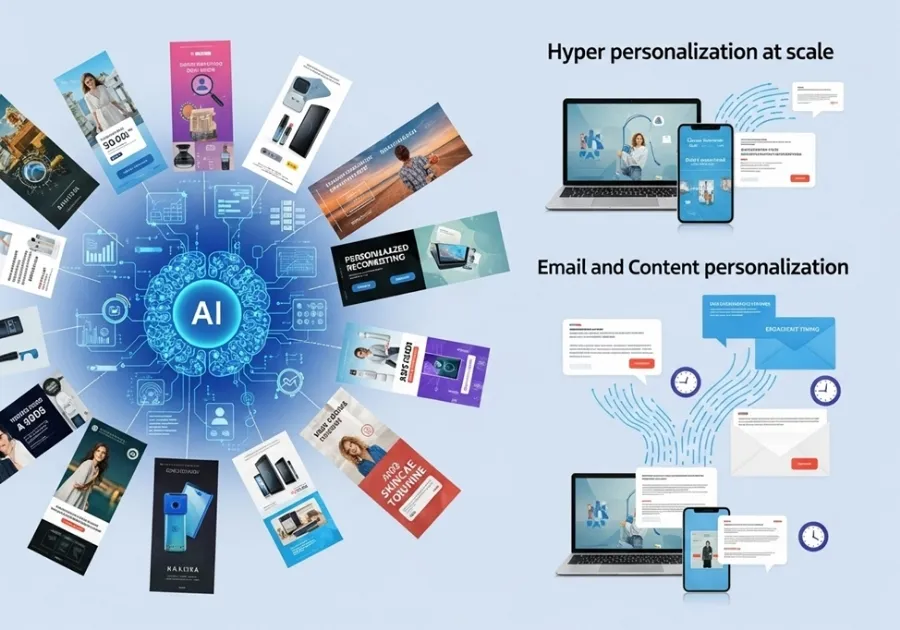
AI-driven personalization can boost engagement by up to 2× and raise conversion rates by ~1.7× (BrandXR, 2024). At the same time, 40% of consumers say most ads they see are irrelevant, which is exactly what AI targeting aims to fix (Bain, 2024). Tools like Dynamic Yield, Persado, and Phrasee are helping brands push the boundaries of what personalization can achieve in practice.
In short, personalization is no longer optional. With AI, it has become the standard expectation in digital marketing, and businesses that adopt it are the ones building stronger, longer-lasting customer relationships.
The Rise of AI in Web Design and Development
Adaptive UX and Smart Interfaces
Just as AI is transforming marketing, it is also reshaping how websites are designed and experienced. In 2025, the focus has shifted from static, one-size-fits-all layouts to adaptive user experiences (UX) powered by AI.
Instead of every visitor seeing the same homepage, AI can adjust layouts, visuals, and even navigation in real time based on user behavior. For example, a returning customer might see personalized product recommendations at the top, while a first-time visitor receives a guided tour of the site. This ensures users spend less time searching and more time engaging.
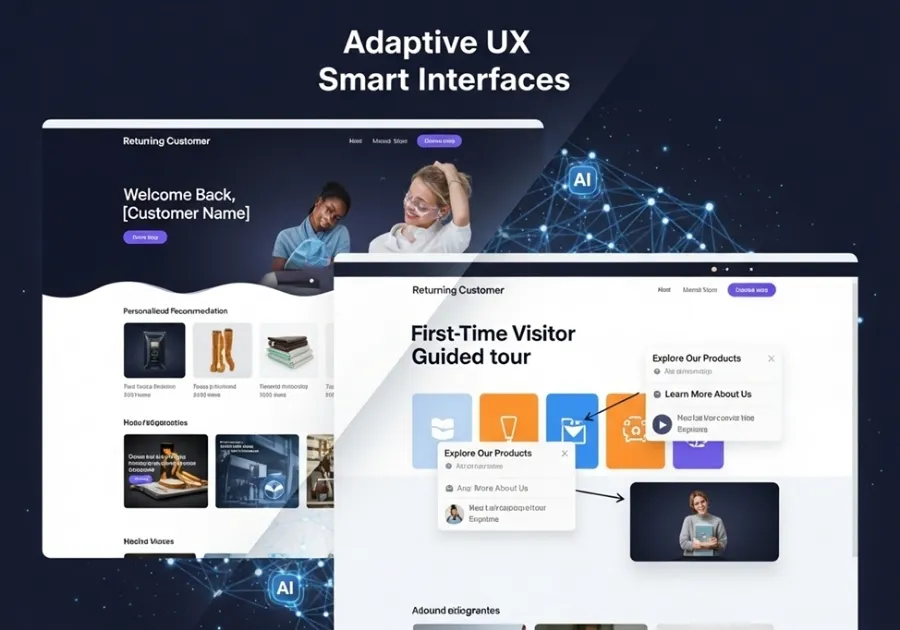
These smart interfaces rely heavily on AI-driven analytics. By tracking browsing paths, scroll depth, and click behavior, AI systems learn how to reorganize site elements for maximum engagement. It’s like having a designer who tweaks the website for each user, but does so instantly, without human effort.
This shift has major implications for both conversion rates and SEO. Google increasingly values user experience signals such as time on page and bounce rate. Adaptive design powered by AI keeps visitors engaged longer, which indirectly boosts rankings and creates a smoother browsing experience. Case studies indicate AI-based UX personalization can reduce bounce rates by ~12% (LinkedIn, 2025).
AI Design Tools and Builders
Another major change in AI for web design is the rise of tools that make building websites faster, smarter, and more accessible. By 2025, both designers and non-designers will be able to use AI-driven builders to quickly generate layouts, color schemes, and even complete prototypes.
Platforms like Uizard, Wix ADI, and Framer AI demonstrate this innovative approach. Instead of starting from scratch, users can simply describe what they want. For example, “a modern portfolio site with a minimalist style,” and the AI quickly offers multiple design options. These tools significantly cut down the time needed for web development and make website creation accessible to people without traditional coding or design skills. The market for AI website builders is expanding rapidly, with projections estimating it will reach about $31 billion by 2030, growing at a compound annual rate of around 31% (Market.us, 2024).
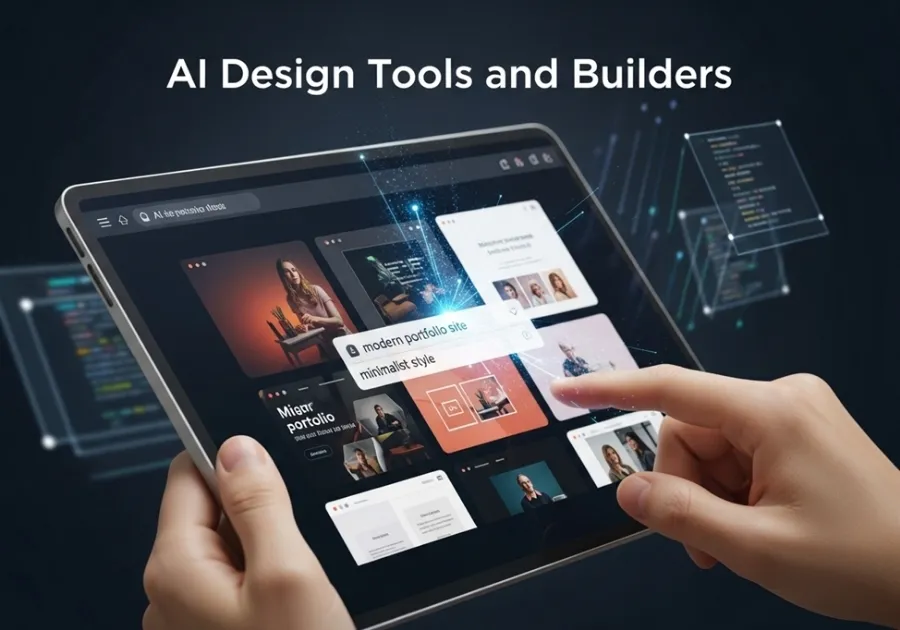
However, this doesn’t mean web developers are being replaced. Instead, professionals are finding ways to combine AI-generated drafts with custom development to achieve both speed and creativity. For example, a theme can be rapidly prototyped with AI and then refined manually for branding and performance.
This is also where ThimPress naturally fits: robust, flexible WordPress themes that pair well with AI-assisted prototyping workflows, keeping speed and accessibility intact. Their WordPress themes already provide flexible, professional foundations for websites. Adding AI-assisted design features can make these themes even more adaptable, giving site owners a good balance between AI-driven speed and human customization.
In short, AI design tools aren’t replacing creativity; they’re boosting it. Developers and designers who use them can spend less time on repetitive tasks and more time creating unique, user-focused experiences.
Chatbots and Conversational Interfaces
No discussion of AI in web design would be complete without mentioning chatbots and conversational interfaces. In 2025, they’ve evolved far beyond the clunky, scripted bots of just a few years ago. Today’s AI chatbots, powered by advanced natural language processing (NLP), can hold realistic conversations, understand context, and provide personalized support in real time.
For businesses, this shift means fewer abandoned carts, faster customer service, and higher user satisfaction. For example, an AI-powered chatbot on an eCommerce site can answer shipping questions, recommend products, or even upsell based on browsing history, without needing a human agent. This reduces bounce rates and increases conversions, which benefits revenue and also indirectly supports SEO. Leadership interest is high: 71% of CMOs say they plan to invest $10M+ annually in AI tools like chat interfaces to improve CX (Cannes Lions CMO Insights / Business Insider, 2025).
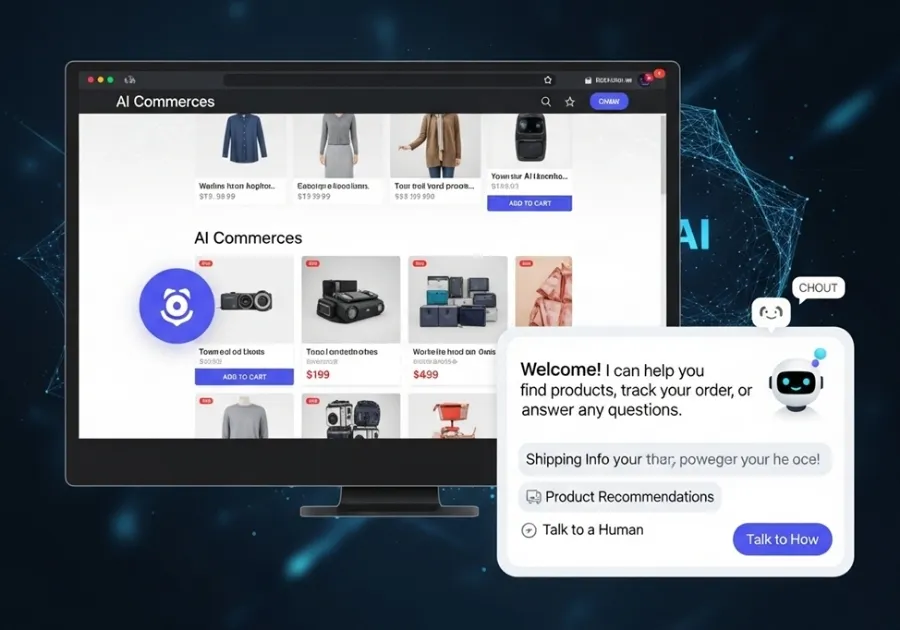
What’s especially interesting is how conversational AI integrates with website design. Many site owners now ask, “How to integrate AI in website design?” This also aligns with evolving search behavior (AEO/answer-engine trends), where conversational experiences on-site help users find answers faster (Industry commentary, 2025). The answer is easier than ever. Platforms like Drift, Intercom, and WordPress plugins make it simple to add smart chat assistants that enhance user experience without complex coding.
For developers, the challenge isn’t whether to use chatbots but how to use them effectively. A well-placed chatbot guides users smoothly, while a poorly implemented one frustrates visitors.
The main point? Chatbots are no longer optional extras. They’re becoming central to modern web experiences, shaping how users interact with brands and raising new standards for what a “smart” website should be.
What does this mean for Marketers, Designers, and Developers?
New Skills and Roles Emerging
As AI takes over repetitive tasks, the true opportunity for professionals in 2025 is creative collaboration with AI. Marketers are no longer just campaign managers. They’re becoming AI strategists, learning how to craft effective prompts, analyze AI outputs, and quickly adapt strategies. For designers and developers, new roles are also emerging.
Prompt engineering, the skill of instructing AI tools, is becoming as vital as coding itself. Developers are also exploring AI model fine-tuning to craft website experiences tailored to specific industries or audiences. This doesn’t mean traditional skills disappear; instead, they evolve. A digital marketer who understands customer psychology now combines that knowledge with AI-driven segmentation.
A web developer skilled in WordPress, PHP, or other platforms can now integrate AI-powered plugins to boost personalization or increase speed. The professionals who succeed will be those who view AI as a co-pilot, not a replacement. Organization-wide adoption supports this shift; 78% of companies now use AI across business functions (Stanford AI Index, 2025).
Ethical and Strategic Considerations
Of course, like any major shift, AI presents challenges. A common question many ask is: “Will AI replace digital marketers and web developers?”
The short answer is no, but it will replace outdated workflows. AI can optimize ads, generate layouts, or answer support questions, but it lacks the nuance of human creativity, strategy, and empathy. Leaders also note adoption strain: ~42% of executives report internal friction over GenAI rollouts, underscoring the need for clear strategy and governance (Writer Survey, 2025). Businesses still need people to set vision, ensure ethical use of data, and build trust with audiences.
Another challenge is data ethics. AI depends on data, but over-personalization can feel invasive if not handled responsibly. Marketers and developers must find a balance between using AI insights for personalization and respecting user privacy.
Strategically, companies also face the risk of over-relying on AI tools. While automation saves time, it can lead to generic campaigns or cookie-cutter websites if not guided by human oversight.
Final Thoughts: Embracing AI Without Losing the Human Touch
AI is no longer a future trend. In 2025, it’s shaping how businesses market, design, and engage with their audiences. From smarter targeting in ads to adaptive web experiences, AI delivers speed, accuracy, and personalization at a scale that was impossible just a few years ago.
But despite these powerful tools, they don’t replace the need for human creativity, empathy, and strategy. Marketers, developers, and designers who succeed will be those who combine AI’s efficiency with uniquely human insights. Leadership teams are already viewing AI as both a growth driver and a responsibility: it can unlock new opportunities, but only if guided ethically and thoughtfully.
For many businesses, the way forward involves experimenting with AI where it makes sense — testing smarter ad strategies (like those pioneered by partners such as Mega Digital) or exploring adaptive web design and AI-driven UX through flexible platforms (like the themes from ThimPress).
The bottom line? AI should serve as an assistant, not a replacement. By keeping the human touch at the core, businesses can confidently embrace this transformation and turn AI into a genuine advantage.
